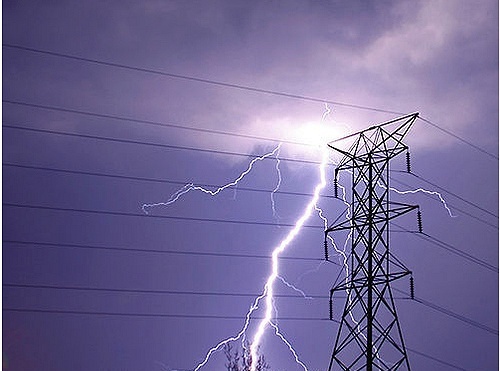Lightning protection cables of overhead power lines
To protect high-voltage power lines from the destructive effects of atmospheric overvoltages (lightning discharges), special lightning protection cables are suspended above the line conductors.
These cables serve as a type of extended lightning rods, the number of which depends on several factors: on the voltage class of the line, on the resistance of the soil surrounding the support, on the place where the support is installed and on the number of wires suspended on it. Depending on the distance between the cable and the nearest protective conductor (depending on the so-called protection angle), the corresponding height of the suspension of the cable on the support is calculated.
If the voltage of the high-voltage line is in the range of 110 to 220 kV, while the line supports are wooden, or the line voltage is 35 kV, regardless of the type of supports, then lightning cables are installed only at the approaches to substations. On lines with steel or reinforced concrete supports, the voltage of which is 110 kV or more, the steel cables are suspended along the entire line.

Either steel or aluminum and steel (aluminum wire with a steel core) is used as the wire rope material. A typical lightning protection wire is made of galvanized steel wires and has a cross section of 50 to 70 mm. When such a cable is suspended on insulators, at the moment of lightning discharge, its current is directed to the ground through a sincere gap installed on the insulator.
In the old days, each protective cable was everywhere firmly grounded at each of the supports, as a result there were significant losses of electricity, this was especially noticeable on ultra-high voltage lines. Grounding of protective cables today is carried out not only through the supports, but also, as noted above, through spark gaps.
So, on lines with a voltage of 150 kV and less, if there is no melting of ice or a high-frequency communication channel along the cable, the insulated installation of the cable is carried out only on metal and reinforced concrete anchor supports. Cable fastening of all supports with voltages from 220 to 750 kV is carried out on insulators, while the cables are shunted directly from candles.

The process of installing lightning protection cables is similar to installing the wires themselves. Cables are usually connected with steel compression connectors. On a high-voltage line with a voltage of less than 110 kV, the cable is attached directly to the support with connecting fittings without an insulator. On a line with a voltage of 220 kV (high and ultra-high class), the cable is attached to the supports through suspension insulators, as a rule, glass, which are shunted by sparks. In each anchor section, a cable is grounded to one of the anchor supports.
Most of the work of installing wires and cables is related to climbing supports. On high-voltage lines with a voltage of up to 10 kV, installers climb the supports, as a rule, using installation claws (shafts) and belts. On lines with a higher voltage class, hydraulic lifts and telescopic towers are widely used.

Since July 1, 2009, during the construction of new and reconstruction of old high-voltage lines, the enterprises of IDGC and PJSC "FSK UES" use steel ropes of the brand MZ-V-OZh-NR, made according to STO 71915393-TU 062, as protection against direct lightning strikes —2008 and grounding wires of the GTK brand according to TU 3500-001-86229982-2010.
Studies have shown that the cables themselves, when suspended from insulators, can be used to transmit small electrical power as well as for high-frequency communication. In recent years, lightning protection cables with built-in optical cables can now be found. It turns out to be cheaper than laying a cable underground, especially when its subsequent maintenance is taken into account.
